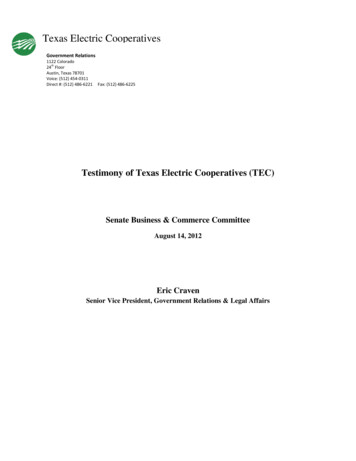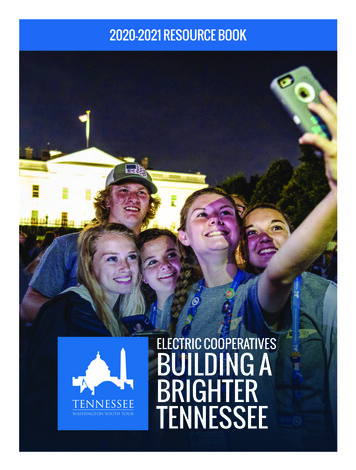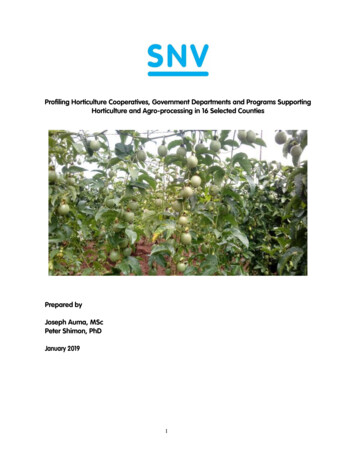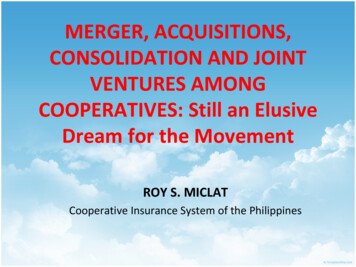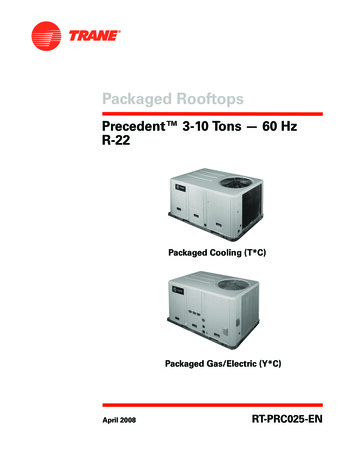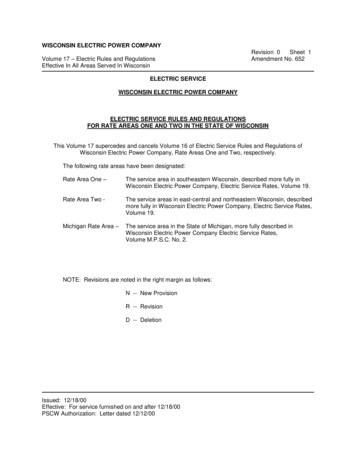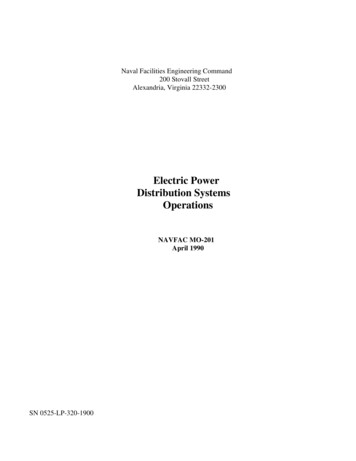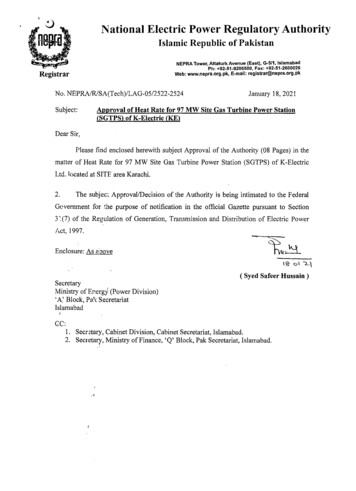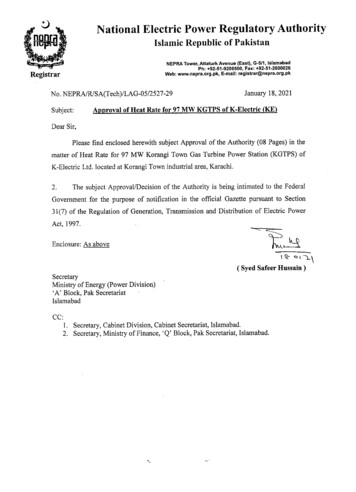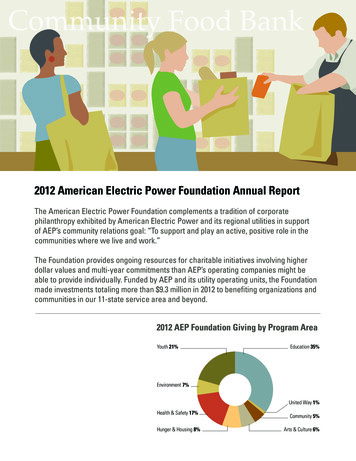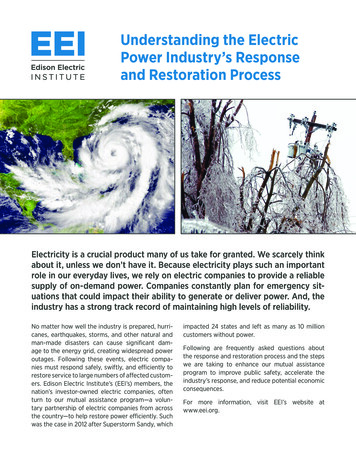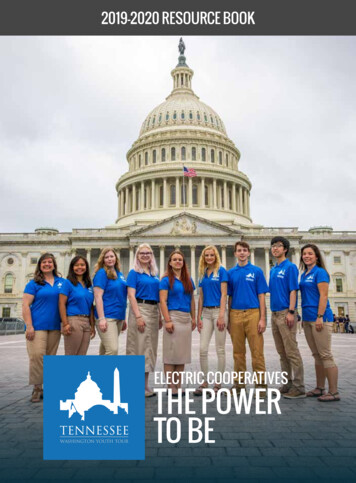
Transcription
2019–2020 RESOURCE BOOKELECTRIC COOPERATIVESWASHINGTON YOUTH TOURTHE POWERTO BE
2
ELECTRIC COOPERATIVEWASHINGTON YOUTH TOURMore than 6,000 high school juniors fromacross Tennessee have participated in theElectric Cooperative Youth Tour since it started in the 1960s.Before you lies a unique opportunity. Winnersof the Electric Cooperative Writing Contestnot only earn spots on a once-in-a-lifetimetour of our nation’s capital, but they alsoqualify for additional trips and thousandsof dollars in scholarships and have a chanceto network with other young leaders fromacross the nation.Exciting stops on the Washington Youth Tourinclude Arlington National Cemerery, above,Martin Luther King Jr. Memorial, right, and theU.S. Capitol, opposite page. Seeing the sitesthey’ve studied in school is a highlight of thedelegates’ D.C. experience.CREATIVE WRITINGAND SCHOLARSHIPCOMPETITIONThis booklet will tell you more about the trip,let you hear from previous delegates andoutline the requirements and resources tohelp you write the best short story. It will alsotell you a little bit more about electric cooperatives and the reasons they have providedthis opportunity to students for more than 50years.3
WHAT YOU GETYour prize for showing the benefits of cooperative power: an unforgettable trip to Washington, D.C., June 19-25, 2020, with nearly2,000 other students your age from across thecountry.Each day of the Washington Youth Tour bringsmore impressive sights, opportunities forphotos and lots of memories. Among activities filling the agenda are tours of Washington, D.C., and all its landmarks, memorials andmuseums. Highlights include the SmithsonianInstitution, White House, U.S. Capitol, MountVernon and Monticello.Food, travel and lodging expenses are paidby Tennessee’s electric cooperatives. But thebenefits of the Youth Tour go far beyond anexpense-paid trip.During the tour, delegates have the opportunity to compete for Tennessee’s spot on theYouth Leadership Council to represent the4TRAVELRECOGNITIONstate at the 2021 National Rural Electric Cooperative Association annual meeting in SanDiego, California.And don’t forget about the chance to helppay for your college education with scholarships of 3,000, 2,000 or 1,000 awardedby the Tennessee Electric Cooperative Association if your story is judged one of the topthree in the state.You may also choose to participate in our Cooperative Youth Ambassador program. Delegates who stay active and engaged with theirco-op in the 12 months following Youth Tourqualify for a drawing for a 10,000 scholarshipto the school of their choice.Electric cooperatives are different from otherutilities. Your locally owned electric co-opgives a lot back to the community. In fact,that’s a major part of its business plan. Electriccooperatives invest thousands of dollars toSCHOLARSHIPSCONNECTIONS
SO MUCH MORETHAN A TRIPsend high school students to Washington because it’s important to the long-term prosperity of their communities for their leaders oftomorrow to learn about the political process.Youth Tour participants return to their hometowns stronger leaders with confidence thatthey can make a difference.The Washington Youth Tour is just thebeginning. Tour delegates have theopportunity to receive additional tripsand a share of more than 400,000in scholarships. Plus, the experiences and contacts you make will last alifetime.In addition to scholarships provided by the electric co-ops,Union University in Jackson, Tenn., has recognized the leadership potential of youth tour delegates. The university hasagreed to provide up to 24 4,000/year scholarships for fouryears and one 10,000/year scholarship for four years.5
HEAR FROM THE WINNERS“Never in my life did I imagine that writing this short story would impactmy life this much. I saw so many things, many of them once-in-a-lifetimeexperiences. Youth Tour has changed my life for the better, all because of a900-word short story.”Olivia Carpenter, Blackman High SchoolMiddle Tennessee Electric Membership Corporation“I didn’t think 900 words could change my life THAT much, but it did. I gotto see my nation’s capital, make friends, eat some great mac and cheeseand learn so much more than what my textbooks at school have to offer.”Anna Herrell, Cherokee High SchoolHolston Electric Cooperative“I knew I was going to have fun on this trip. I didn’t know it would be withso many new friends. I never thought that making friends would ever be soeasy or that I would get along with new people this well.”Makenzie Dale, Tellico Plains High SchoolFort Loudiun Electric Cooperative“Thanks to this trip, I will approach senior year and life differently. This triphas shown me how many opportunities there are in life; you just have tobe willing to look for them.”Brooke Jackson, Fayette Ware High SchoolChickasaw Electric Cooperative6
JOIN A NATIONALFELLOWSHIPEach day of the Washington Youth Tourbrings more impressive sights, opportunities for photos and lots of memories.Among activities filling the agenda aretours of Washington, D.C., and all its landmarks and memorials.2019 ROBERT MCCARTY MEMORIALSCHOLARSHIP WINNERSJacob Coble,Perry County High School, Meriwether Lewis ElectricCooperative, 3,000 ScholarshipAlyssa Hampton,Riverside ChristianAcademy,Fayetteville PublicUtilities, 2,000 ScholarshipMelanie Garcia,Dyer CountyHigh School ,Appalachian Electric Cooperative, 1,000 ScholarshipPoliticians, authors, athletes and businessleaders, includingApple CEO TimCook, areproud YouthTour alumni.2019 CO-OP YOUTH AMBASSADORSCHOLARSHIP WINNERKeslin Moore,Munford High School ,Sequachee Valley ElectricCooperative, 10,000 ScholarshipDelegates who stay engaged and active withtheir local co-op in the year following theYouth Tour have a chance to win a 10,000scholarship to the college or trade school oftheir choice.7
RULES AND RESOURCESThe energy provided by electric co-ops has far-reaching impacts on Tennessee. Write ashort story explaining how electric co-ops give their consumers the “power to be” connected, engaged, productive, healthy, educated, etc. How does affordable and reliableenergy from your co-op impact your life?There are a few rules you need to follow:1. Only juniors in high school are eligible toparticipate.2. Every short story must be titled “RuralRenaissance.”3. Submissions must not exceed 900 words,including articles (“a,” “an” and “the”). Theexact word count must be included on yourcover page. Entries must be typewritten anddouble-spaced.CO-OP CONTACT PERSONEMAIL ADDRESSDUE DATE8Remember, you’re writing a short story, whichgives you more creative freedom than therigid guidelines of an essay. Your story shouldbe an entertaining, informative description ofelectric cooperatives.Visit youthtour.tnelectric.org to learn moreabout electric co-ops. Resources there willprovide you with lots of information and material to write your story.
JUDGINGCRITERIALEARN MORE ONLINE ATYOUTHTOUR.TNELECTRIC.ORGThere are several resources on our websiteat youthtour.tnelectric.org to help you writeyour story.CHECKLIST FOR SUCCESS:The tips below can help you get one stepcloser to D.C. Use these suggestions to makeyour story stand out.Characters, time and placeSpend some time to develop the characters,location and time frame of your story.Get specificInclude at least three specific examples of themany ways that co-ops connect their communities. The expansion of broadband, availability of reliable energy, efforts to recruit newbusinesses and jobs and young leadershipdevelopment for young people are just a fewexamples.Include one (or more) co-op principlesThe seven principles of electric co-ops are listed on pages 14 and 15. Include these in yourstory to demonstrate your understanding ofthe many things that make electric co-opsunique.Be creative in your writing, utilizingthe information in this booklet andyour own distinctive voice. Your writing will be judged on three factors:Appropriate treatment of theme50% and knowledge of subjectTo gain full credit in this category,you’ll have to effectively weave theinformation relating to the themethroughout the short story. Judges willsee indications of additional research,a grasp of what information is vitalto making your story believable andcredible and creative ways of presenting that information.Originality and 35% CreativityUse a different, entertaining, effectiveway of presenting information that willeducate a reader and get your pointsacross.15%Grammar and CompositionIf you need an explanation here, checkyour English textbook.9
LAST YEAR’S WINNING STORYHarry was, once again, being fed a paralyzing lineof questions by Arthur Weasley, the muggle-obsessed father of the family, during a visit to theWeasleys’ home with Ginny and their children,James, Albus Severus, and Lily. And while he was,in fact, after some consideration, able to explainrubber ducks to Mr. Weasley, this new topic wasmore unsettlingly random than any other topicHany had encountered before. This was, in fact,his second greatest challenge since the Dark Lordhimself. Mr. Weasley simply had to know:“Harry, what are these electrical cooperatives?”He asked, hopefully. His childlike enthusiasm wasnever more prominent than in his inquiries intothe nature of muggle technologies. He continued,saying, “I read about them once, in a muggle pamphlet I collected on a trip to America.”Arthur was always collecting as much muggleinformation as possible, And Harry, having just finished explaining the general concept of electricityto Mr. Weasley, was exhausted by the prospectof having to find out what electric cooperativeswere. But Harry could hardly refuse him, so hetold Arthur he would “Look into it for you,” and leftfor the day. He could hardly wait to get out of Mr.Weasley’s sight for the night.The next morning, before anyone could wake upto discover him, Harry slipped out of bed, takingcare to avoid waking Ginny, and reluctantly tookto the internet, remembering as much of his Mug-10gle Studies lesson on the World Wide Web, as theycalled it, as he could to search for “Electric Cooperatives’’. The result he chose took him to a websitefull of information about Tennessee cooperatives.Good enough, right? Tennessee is a state in America, so this has to be what he wants to know, hethought. He began reading.Harry was surprised at how intrigued he was.Muggle technologies hardly interested Harry, buthe found himself reading page after page of thisinformation that was completely useless to him.Behind a veil of curious excitement and nervousshame, he looked through as much informationas he could. Harry learned more that day aboutmuggles than he had any day since the Dursleyshad left. He knew, for instance, that cooperatives,or “Co-ops” for short, power over 1.1 millionplaces in Tennessee. They were responsible for thepower in 1 in 3 Tennessee homes, giving power to2.5 million Tennessee muggles 99.96 percent ofthe time. He kept reading and found out that theywere not-for-profit, a muggle way of saying thatthey weren’t greedy, and that they were ownedand regulated by their members. Their members,of course, were their customers and the peoplethat owned the cooperatives themselves. Harryknew that to Arthur this would all be very confusing. He braced himself for the hours he knew wereahead of him and kept reading.Harry thought that these electric cooperativeswould be something Hermione would like, re-
ELECTRIC COOPERATIVES:GOING BEYOND THE WIREScalling her role in S.P.E.W and her obsession withhouse elves during their fourth year at Hogwarts.This was because the businesses gave 2,600people jobs in rural areas, gave to philanthropiccauses, and paid 63 million dollars, Americanmuggle money, in taxes that went towards roads,schools, and parks. Cooperatives also savedTennesseans millions of dollars on prescriptionsand medical bills with what was called the Co-opConnections Card. Harry had thought he would beexplaining something simple to Arthur, but nowHarry could see his future conversation with Mr.Weasley growing longer and more complex bythe minute. Nevertheless, Harry forged ahead andkept reading.Electric cooperatives arefull of some really bignumbers. Harry thought as he discovered that,in addition to all of the other gigantic numbershe had to remember to tell Mr. Weasley about,83,000 miles of power lines, the “wires in the air”that he had explained to Arthur yesterday, weremaintained by the co-ops. These and the otherequipment used by the co-ops cost in total 2.8billion American dollars, which was about 2 billionpounds. Harry hoped the conversion would helpArthur understand; muggle money was alsobeloved to Arthur, and Harry knew he understoodit at least marginally. Harry remembered theother money-related facts he learned and made amental note to tell Arthur all of the dollar ainounts, such as the 94 million dollars in wages andbenefits earned by co-op employees and theSilas Freeze, a student at Obion CountyCentral High Schoolwho was sponsored byGibson Electric Membership Corporation,was the state winnerof the 2018 Washington Youth TourWriting Contest, earning him a 3,000scholarship.This year’s theme is “Inspiring a RuralReniassance. Write your story aboutthe many ways co-ops have helpedrural towns grow into thriving communities.4 million dollars in economic development loansco-ops had secured in 2013, in pounds.Satisfied with everything he had learned, HarryPotter closed the webpage he had opened andprepared himself for the conversation with ArthurWeasley that was imminently looming over him.Armed with a few notes and the knowledge hehad gathered, Harry stepped into the living roomof the Weasleys’ home to find Arthur awake,reading The Daily Prophet. Harry looked at himas he put the paper down and cracked a smileHarry knew all too well. It was the smile of Arthur’smuggle curiosity, and for once, Harry was happyto oblige.11
TENNESSEE’S ELECTRIC CO-OPSTennessee’s electric cooperatives providepower to more than 1.1 million homes, farmsand businesses across rural and suburbanTennessee. Unlike other businesses, electriccooperatives are owned by the consumersthey serve and operate as not-for-profit businesses. This may not sound important, but itmeans that consumers are the priority. Ratesare kept low because there are no stockholders to pay, and the co-op is responsive tomembers because they vote on co-op leadership.In the 1930s, there was no power in ruralTennessee. Homeowners and farmers cametogether to create co-ops that would bringpower to their homes.Today, co-ops are modern businesses thatuse technology to efficiently operate a large,advanced grid. Despite these changes, theprimary goal of co-ops have not changed:provide safe, reliable and affordable energy toour neighbors, the very people who own theco-op.MEMBER-OWNED AND -REGULATEDElectric co-ops are owned by the people they serve, not by government.Members elect board members to represent their interests and set policy andprocedures for the co-op.NOT-FOR-PROFITCo-ops exist to serve their communities instead of shareholders. They distribute and sell energy at cost and invest any excess revenue back into the electricsystem.COMMITTED TO IMPROVING COMMUNITIESKeeping the lights on. Recruiting new industry. Educating the leaders of tomorrow. Electric co-ops take seriously their responsibility to improve lives in theircommunities.12
ELECTRIC CO-OPSSERVEBecause of their local ties, co-ops are committed to improving lives in their communities.Going beyond simply keeping the lights on,co-ops recruit businesses and investment,help members operate their homes and businesses more efficiently and prepare studentsto be tomorrow’s leaders.
CO-OP HISTORY AND PRINCIPLESCO-OPHISTORY INTENNESSEETHE SEVENCOOPERATIVEPRINCIPLES14MID-1880SEARLY 1930SMAY 18, 1933Electricity wasavailable in many ofAmerica’s larger cities, but electrificationof rural areas wasdeemed unfeasible.For-profit powercompanies considered it unprofitableto build lines insparsely populatedrural areas. Withoutelectricity, the economies of rural areaswere tied exclusivelyto agriculture.President FranklinD. Roosevelt signedthe Tennessee ValleyAuthority Act, whichcreated a federalagency to provideriver navigation,flood control, electricgeneration and economic developmentin the TennesseeValley.VOLUNTARY AND OPENMEMBERSHIPDEMOCRATIC MEMBERCONTROLMEMBERS’ ECONOMICPARTICIPATIONCo-ops are voluntaryorganizations opento all persons ableto use their servicesand willing to acceptthe responsibilities ofmembership.Co-ops are democratic organizationscontrolled by theirmembers, who activelyparticipate in settingpolicies and makingdecisions.Members contributeequitably to the capitalof their co-op. Members allocate surplusesto further develop thecooperative or supportother activities approved by members.
MAY 11, 19351935–19481949TODAYPresident Rooseveltcreated the RuralElectrification Administration, whichmade federal fundsavailable to providerural electric service.The leaders of farmorganizations proposed the formationof nonprofit electriccooperatives.Tennesseans formed23 electric cooperatives to bring electricity to rural areas.Postwar enthusiasmand adaptations ofmilitary technology, materials andequipment propelledrapid growth of ruralelectrification. By the1950s, the TennesseeValley Authority hadbecome the nation’slargest energysupplier.Tennessee’s 23electric cooperativesprovide energy for2.5 million Tennesseans across 71 percentof Tennessee’s landmass. Co-ops rely onthe latest technologyto efficiently andreliably serve onein three Tennesseehomes.AUTONOMY ANDINDEPENDENCEEDUCATION, TRAININGAND INFORMATIONCOOPERATION AMONGCOOPERATIVESCONCERN FORCOMMUNITYCo-ops are autonomous organizationscontrolled by theirmembers.Co-ops provide education and trainingfor their members,representatives andemployees on thenature and benefits ofcooperation.Co-ops serve theirmembers most effectively by workingtogether through local,national, regional andinternational structures.Cooperatives workfor the sustainabledevelopment of theircommunities throughpolicies accepted bytheir members.15
WASHINGTON YOUTH TOURPRESENTED BY YOUR LOCAL ELECTRIC COOPERATIVE AND2964 Sidco Drive, Nashville, TN 37204615.367.9284 tnelectric.org
businesses and jobs and young leadership development for young people are just a few examples. Include one (or more) co-op principles The seven principles of electric co-ops are list-ed on pages 14 and 15. Include these
